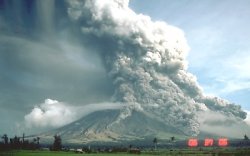Predicting Volcanic Eruptions Months in Advance
 Volcanoes are easier to predict than earthquakes. While seismologists still argue about whether detectable pre-earthquake effects exist at all, volcanologists agree that eruptions are preceded by the movement of magma from someplace very far underground to a configuration nearer the surface. The magma’s movement can be observed over periods of years to days, by examining signals such as the tilt and bulge of a volcano’s surface, the earthquakes magma produces as it moves, and the gases emitted from fumaroles.
Volcanoes are easier to predict than earthquakes. While seismologists still argue about whether detectable pre-earthquake effects exist at all, volcanologists agree that eruptions are preceded by the movement of magma from someplace very far underground to a configuration nearer the surface. The magma’s movement can be observed over periods of years to days, by examining signals such as the tilt and bulge of a volcano’s surface, the earthquakes magma produces as it moves, and the gases emitted from fumaroles.
This week, two studies were published that represent significant improvements in our ability to track magma underground, and, hopefully, to predict future volcanic eruptions.
The first study was performed on the volcanic island of Montserrat. Researchers from the University of Leeds and the British Geological Survey examined more than 500 so-called “volcanotectonic” earthquakes that occurred on the island during ten years of activity at the Soufrière Hills volcano. By looking at the seismic signals recorded around the volcano, they were able to tell in which direction each eathquake had squeezed the earth, and in which direction it had pulled and stretched it out like taffy. During the months leading up to each of three major eruption events, they found, the direction of the squeezing changed from northeast-southwest to northwest-southeast.
The change in direction occurs because prior to an eruption, fresh magma from below must reach shallower holding chambers in the volcano. Normally, the rock through which it must travel is being squeezed by tectonic forces. In the case of Montserrat, the squeeze comes from the convergence of the Caribbean and North American plates, which occurs along a roughly northwest-southeast boundary. It’s easiest for the magma to travel along a path that’s at right angles to the direction of squeezing – it’s sort of like when you smash a little packet of ketchup, it all squirts out the sides rather than up onto your fist. What that means is that normally, earthquakes show squeezing at right angles to the plate boundary, i.e., northeast-southwest. But when magma’s on the move in the months preceding an eruption, it creates earthquakes that show squeezing in the direction of the magma’s motion – northwest-southeast.
Few other signals provide reliable warning of an upcoming eruption more than a few weeks in advance. At a volcano like Soufrière Hills, which erupted in 2020, 2020, and 2020, the signs of an eruption’s end are especially difficult to distinguish from the signs of a new eruption beginning. This earthquake analysis, however, is able to tell the difference.
Although the study used a catalog of old earthquakes, the authors used techniques that can be applied to earthquakes as they occur, so that changes in the squeeze direction can be detected in time to plan for an evacuation. A volcano monitoring plan that used this technique could provide weeks of additional warning for emergency planners. The study is in the August 15 issue of Earth and Planetary Science Letters; for those of you with a subscription, here’s a direct link.
The second study is in this week’s Science – and this one has a nice perspectives article written about it as well. Scientists from the Italian National Institute of Geophysics and Volcanology used a technique called four-dimensional seismic tomography to view magma rising through Mt. Etna.
In normal 3D seismic tomography, the time it takes seismic waves to travel from earthquakes to a large array of receivers is used to determine the seismic wave speed in the rocks between the quakes and the receivers. Wave speed is correlated to physical properties of rock like temperature and composition. What makes 4D tomography special is that it allows the physical properties of the rock to vary in time as well as space, so you can see changes due to rising magma. What makes it difficult is that you need a shitload of data. However, Mt. Etna is covered by a dense seismic network, and generates lots of earthquakes.
Four-dimensional seismic tomography is currently used to monitor conditions at the Coso geothermal energy facility in California; it’s also been used on other volcanoes. But this is the first time that it’s captured an eruption in process.
Finally, the USGS has a neat little exercise where you can try your hand at predicting the behavior of Mt. St. Helens.
See You at Enceladus » Blog Archive » Blog Carnivals Reminders & Something to Read on 12 Aug 2020 at 11:46 pm
[...] A volcano, Mount Mayon in the Philippines, is going to erupt soon. Green Gabbro has the scoop on two new development in eruption prediction. [...]
Panta Rei - 2nd Edition: What’s the Difference at Kyun.org on 28 Aug 2020 at 10:20 pm
[...] Yami McMoots tells us about 2 key advancements that will improve our ability of predicting volcanic eruptions. There’s a whole lot of squeezing and rising going on. The links require paid subscriptions. [...]